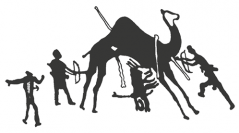

 Anthropozoologica
49 (2) - Pages 207-224
Anthropozoologica
49 (2) - Pages 207-224Bone remains of camel (Camelus dromedarius) have been found in several sites of south-eastern Arabia, dating from the Late Holocene period to the Bronze Age, and generally attributed to wild animals. The new camel finds from the Early Bronze Age site of Ra’s al-Hadd (HD-6) – dated with radiocarbon technique between 2890-2580 BC – are the oldest camel evidence in the Sultanate of Oman. This discovery represents an opportunity for a critical review of all available data in the Arabian Peninsula. These remains are important because widen our knowledge about camel spreading trajectory and raise an obvious question about its omestication or wild status. This study contributes to the debate about camel status and the relationship between late prehistoric communities and this animal.
Camel, domestication, Bronze Age, Sultanate of Oman